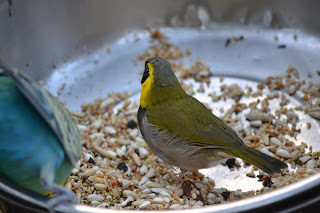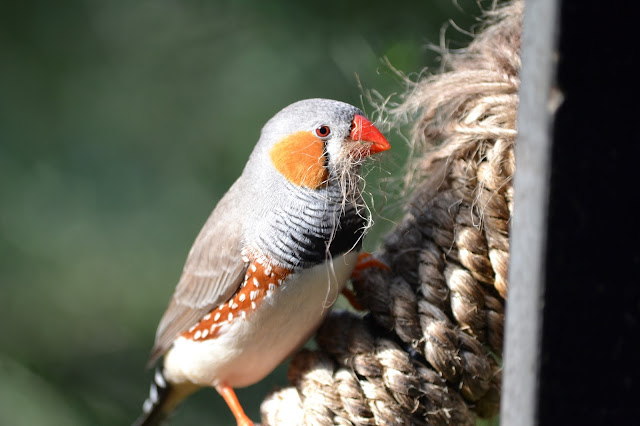Hi all and welcome to this quick Blog brought to you from Vancouver, BC, Canada.
This adventure is a fairly small one but one that I was fairly impressed to see.
First off food and then off to the Queen Elizabeth Park to see the Bloedel Conservatory which was amazing.
***
So lets get into it!
***
As we travel we like to seek out and support our fellow vegans and see what new things they have to offer so this time we checked out:
Above: Photo stolen from: http://ilovechickpea.ca/
Below: What we ate and what it looks like Kasum on the left Shawarma on the right
This was an interesting restaurant as they have achieved something that I had never seen before. Chickpea fries! So as far as I can tell they were made from chickpea flower aka gram flour aka chana flour. The texture was like a fried tofu crispy on the outside and like a pancake in the middle.
My guess at how they were made was a sort of pancake mix but with chickpea flour instead (salt, water, chickpea flour + you could add what ever other flavours that you might like). I imagine that the mixture is then left to sit till it dries out a bit, then it would be cut into pieces and fried. Again this is all just a guess!
Everything at this place was cool. The menus were hard cover children's books with the middle removed and the menus inside, the staff were super friendly and as can be expected fairly hippy. The overall feel of the restaurant was chilled, with a corner for children to play. Prices were comparable to what can be expected for Vancouver area (A bit expensive) overall I would definitely go again! They have a lot of impressive looking food on the menu and I only got to try two of their plates so I will have to head back there some time in the future. If you are a banana lover with a sweet tooth they have a breakfast option that looks pretty lush.
All menu photos from: http://ilovechickpea.ca/restaurant-menu/
Below: Some of the art from the walls of the restaurant


Bloedel Conservatory
This is a dome that is built upon the highest point in Vancouver city. The conservatory is said to be home to more then 120 free-flying birds and 500 exotic plants.
Sounds impressive, sounds big, it was actually quite small, which wasn't bad it just meant that there were birds ALL around you!
There were a lot of smaller birds like finches as well as large parrots and everything in between.
Above: As we walked in there were little zebra finches that were sitting on the rope pulling the fibers out to make their nest with. They were just on the side of the walk way and not even fazed that we were right there.
All the birds in the conservatory were so used to having people around that you had to be careful not to stand on them. There were also the parrots that were cheeky and would whistle at you as you walked by, or say "hello" and that was super fun to hang around.
The Conservatory as I mentioned was quite small (if you have read my blog on the Eden project, those domes were a lot bigger. http://findlatertravels.blogspot.ca/2016/06/the-eden-project.html), but we just kept walking around and around, each time that you walked around you saw new and different birds each time.
There were two birds that we found very peculiar the pin-tailed whydah (Below left) that looked like someone had stuck feather extensions on his tail as they were way to long for it tiny size and the Gloster Fancy Canary(educated guess)(Below Right) which looked like it's mother had given it and bowl cut.(Sorry the photos are not the best)


As the birds were so tame there were many opportunities to practice our photography skill/ not skills and get some good photos (and not so good photos) so here they all are. I will try to let you know what all the birds are as we go along but I must admit I am not an ornithologist nor an avid bird watcher so there are some I don't know and others that I may well be wrong about.
Above: These two beautiful sisters are Carmen and Maria they are green winged macaws which are the second largest parrots in the world.
Macaws almost always form bonded pairs and can live anywhere from 60 to 80 years old.
Below left: I think that this is an orange bishop weaver. The orange bishop weaver builds a hanging nest and the females will supposedly inspect all the nests to see who is the best architect.The males however will have multiple females on the go at the same time. I suspect this little fellow of being a male.
Below right: This one I am not sure of but I suspect it is a society finch. If so these finches have never existed in the wild but came about as a result of cross-breeding in Asia centuries ago. They also apparently make good foster parents often nurturing the young of other birds in an aviary setting.


Below left: This is Art he is a blue and gold Macaw. He uses his powerful beak for breaking nutshells, and for climbing up and hanging from trees. In this photo he was actually dancing for us.
Below right: Red winged laughing thrush - This bird is from Asia (China and Vietnam) and according to Wikipedia the Isle on Man (UK) as there have been a number of records of the species on the Isle of Man since 1995 after some birds escaped from captivity.


Below Left: I couldn't work out what this little fellow was, I would guess a finch of some variety so we shall call him finch sp. (sp. stands for species and is usually used in science when the species is not able to be determed)
Below Right: This is Rudy I nick named him Pervert. There was a girl that wasn't paying him any attention and he sat there whistling (proper sexy whistling) at her until I walked up and talked to him! Rudy is a Congo African Grey Parrot, these parrots are thought to be the most intelligent of all birds, so intelligent that they are ranked up there with dolphins and chimpanzees for their ability to associate human words with meanings, shapes and colors.


Below Right: This fella is Cramer, he is a Moluccan cockatoo, they are the largest of the cockatoo family and are endangered in the wild.


Below left: This is Ruby, she is an Eclectus Parrot or other wise known as a King Parrot. The male parrot of this species are an emerald green while the females look just like Ruby here.
Below Right: A Cuban Finch and a budgie, I don't really have anything to say about this one only to say Kyran took this photo and I thought it was good so I included it.


Below Left: This is Monty while I am not sure wheather Monty is male or Female, Monty is a Princess Parrot and is native to central and Western Australia though they are rarely seen in the wild.
Below Right: I'm taking a guess an am going to say that this is Gidget, a citron crested cockatoo. The reason that I am guessing is that the conservatory also has a Sulphur Crested Cockatoo and the difference between those species is hard for me to desern from this photo.


Above: The is another finch that I have no idea what it is so we are going to have to leave it as finch sp.
Now let me quickly mention some of the plants that were in the conservatory.
Roxburgh Fig or Indian Fig
Ficus auriculata
This is fig is used for fodder in Nepal but even more interestingly is how it is pollinated. It is pollinated by insects!
Here is how it works:
"Adults enter through the fig ostiole (a), a narrow, bract-lined passage, then pollinate and attempt to oviposit on the flowers (b). Flower ovules that receive an egg (c) become galled and the larvae consume the gall tissue (d). Pollinated flowers missed by the wasps produce one seed each. The adult offspring emerge from the gall and mate in the fig (e), before the winged female wasps disperse, carrying the flower pollen with them (f)(g)."
Text: (https://en.wikipedia.org/wiki/Ceratosolen)
Photo: Edited from Bloedel Conservatory information board.
African popcorn Plant
Senna didymobotrya
Also known as Candle Bush, African senna, popcorn senna, candelabra tree, and peanut butter cassia
A part of the Legume family this tree gets the nickname popcorn plant from the smell that it releases when you rub its bark. The plant also releases the buttered popcorn smell when it becomes bruised.
This plant also serves as treatment for fungal and bacterial infections, as a numbing agent to stun fish (by fisherman making the fish easier to catch), as a coloring agent for textiles (the flowers). The bark is used in leather tanning and the wood for handicrafts and firewood and when it is all burned up the ash of burnt twigs can also be used to coat the inside of gourds to extend to shelf life of stored milk.
This plant although native to Africa has been spread to other parts of the world. So if you are in an of these countries ( Indonesia, Australia, Mexico, and the United States in California, Florida, and Hawaii) have a look and see if you can see a tree that smells like popcorn when you rub it.
Here are some extra random photos that we took along our journey:
Below: Vancouver City
If you do like reading our blog you should consider subscribing/following us, that way you know each time a new blogs gets posted.
 If you want to contribute to keep the blog full of adventures I have set up a Paypal account that you can donate to.
If you want to contribute to keep the blog full of adventures I have set up a Paypal account that you can donate to. paypal.me/findlatertravels
Also if there is anything that is around where we are and you want us to see it/review it please do let us know! we would love to hear from you. Send us an email at:
findlatertravels at hotmail.com

















































